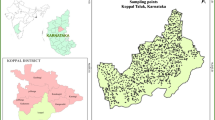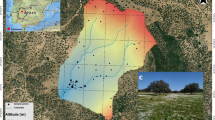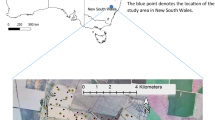Abstract
The design and application of multiple tools to map soil micronutrients is key to efficient land management. While collecting a representative number of soil samples is time consuming and expensive, digital soil mapping could provide maps of soil properties fast and reliably. The objective of this research was to predict the spatial distribution of soil micronutrients within the piedmont plain in northeastern Iran using random forest (RF) and support vector regression (SVR) algorithms. Sixty-eight locations with different land uses were sampled to determine the content of iron, manganese, zinc and copper in the topsoil (0–20 cm). Forty-one digital covariates were used as input to the models and were derived from a digital elevation model, open-source remote sensing (RS) data (Landsat 8 OLI and Sentinel 2A MSI images), WorldClim climate database and maps of soil properties. Covariates were grouped into 11 scenarios: I–III, based on RS data; IV–VI, including RS, topographic, climate and soil covariates; VII, VIII and IX, based only on topographic, climate and soil covariates, respectively; X and XI, based on recursive feature elimination and expert opinion, respectively. The RF algorithm gave 91, 94, 91 and 108% normalized root mean squared error values for iron, manganese, zinc and copper, respectively, for the validation dataset with scenario XI. The most important digital covariates for micronutrients prediction with both RF and SVR models were precipitation seasonality, mean annual temperature and the mean saturation index based on Sentinel 2A MSI data. Digital maps produced at 30 m spatial resolution using scenario XI could be used to effectively identify micronutrient deficiencies and excess hotspots.




Similar content being viewed by others
Data availability statement
The datasets generated during and/or analysed during the current study were available in the [Scenario_based_DSM_Micronutrients] repository, [https://doi.org/10.5281/zenodo.7008079].
References
Adhikari K, Owens PR, Ashworth AJ, Sauer TJ, Libohova Z, Richter JL, Miller DM (2018) Topographic controls on soil nutrient variations in a silvopasture system. Agrosyst Geosci Environ 1:1–15. https://doi.org/10.2134/age2018.04.0008
Alloway BJ (2013) Heavy metals and metalloids as micronutrients for plants and animals. In: Alloway B (eds) Heavy Metals in Soils. Environmental Pollution, vol 22. Springer, Dordrecht. https://doi.org/10.1007/978-94-007-4470-7_7
ALOS PALSAR (2021) Dataset:© JAXA/METI ALOS PALSAR L1.0 2007. Accessed through ASF DAAC 05 September 2021
Azizi K, Ayoubi S, Nabiollahi K, Garosi Y, Gislum R (2022) Predicting heavy metal contents by applying machine learning approaches and environmental covariates in west of Iran. J Geochem Explor 233:106921. https://doi.org/10.1016/j.gexplo.2021.106921
Bagherzadeh A, Ghadiri E, Souhani Darban AR, Gholizadeh A (2016) Land suitability modeling by parametric-based neural networks and fuzzy methods for soybean production in a semi-arid region. Model Earth Syst Environ 2:1–11. https://doi.org/10.1007/s40808-016-0152-4
Blume HP, Brümmer GW, Fleige H, Horn R, Kandeler E, Kögel-Knabner I, Wilke BM (2016a) Soil-plant relations. In: Blume HP, Brümmer GW, Fleige H, Horn R, Kandeler E, Kögel-Knabner I, Wilke BM (eds) Scheffer/SchachtschabelSoil Science. Springer, Berlin, Heidelberg, pp 409–484 https://doi.org/10.1007/978-3-642-30942-7_9
Blume HP, Brümmer GW, Fleige H, Horn R, Kandeler E, Kögel-Knabner I, Wilke BM (2016b) Soil Organic Matter. In: Blume HP, Brümmer GW, Fleige H, Horn R, Kandeler E, Kögel-Knabner I, Wilke BM (eds) Scheffer/Schachtschabel soil science, Springer, Berlin, Heidelberg, pp 55–86 https://doi.org/10.1007/978-3-642-30942-7_3
Breiman L (2001) Random forests. Mach Learn 45:5–32. https://doi.org/10.1023/A:1010933404324
Brown KS, Libohova Z, Boettinger J (2017) Digital Soil Mapping. In: Ditzler C, Scheffe K, Monger HC (eds) Soil survey manual, USDA Handbook 18. Government Printing Office, Washington, D.C, pp 295–354
Carr D, Lewin-Koh N, Maechler M, Sarkar D (2021) hexbin: Hexagonal Binning Routines. https://CRAN.R-project.org/package=hexbin
Carslaw DC, Ropkins K (2012) openair-an R package for air quality data analysis. Environ Model Softw 27–28:52–61. https://doi.org/10.1016/j.envsoft.2011.09.008
Chagumaira C, Chimungu JG, Nalivata PC, Broadley MR, Nussbaum M, Milne AE, Lark RM (2022) Mapping soil micronutrient concentration at national-scale: an illustration of a decision process framework. Egusphere. https://doi.org/10.5194/egusphere-2022-583
Chen S, Arrouays D, Mulder VL, Poggio L, Minasny B, Roudier P, Walter C (2022) Digital mapping of GlobalSoilMap soil properties at a broad scale: a review. Geoderma 409:115567. https://doi.org/10.1016/j.geoderma.2021.115567
Cortes C, Vapnik V (1995) Support-Vector Networks. Mach Learn 20:273–297. https://doi.org/10.1007/BF00994018
Denton-Thompson SM, Sayer EJ (2022) Micronutrients in food production: what can we learn from natural ecosystems? Soil Syst 6:8. https://doi.org/10.3390/soilsystems6010008
Droz B, Payraudeau S, Rodríguez Martín JA, Tóth G, Panagos P, Montanarella L, Borrelli P, Imfeld G (2021) Copper content and export in european vineyard soils influenced by climate and soil properties. Environ Sci Technol 55:7327–7334. https://doi.org/10.1021/acs.est.0c02093
Drucker H, Burges CJC, Kaufman L, Smola AJ, Vapnik V (1997) Support vector regression machines. Adv Neur in 9:155–161
ESA (2015) European Space Agency. Sentinel-2 User Handbook Rev 2. Available from: https://sentinels.copernicus.eu/documents/247904/685211/Sentinel-2_User_Handbook.pdf/8869acdf-fd84-43ec-ae8c-3e80a436a16c?t=1438278087000
ESRI (2021) ArcGIS user’s guide, http://www.esri.com
FAO (2022a) Soils for nutrition: state of the art. Rome. 78 pp. Accessed on link: https://doi.org/10.4060/cc0900en. Accessed date: 18/08/2022a
FAO (2022b) FAO's Global Soil Partnership kicks start a country-driven process to map soil nutrients and soil nutrient budgets at all scales. Accessed on link: https://www.fao.org/global-soil-partnership/resources/highlights/detail/en/c/1601502/
FAO and ITPS (2018) Global Soil Organic Carbon Map (GSOCmap) Technical Report. Rome. 162 pp. Accessed on link: https://www.fao.org/3/I8891EN/i8891en.pdf
Fick SE, Hijmans RJ (2017) WorldClim 2: new 1km spatial resolution climate surfaces for global land areas. Int J Climatol 37:4302–4315. https://doi.org/10.1002/joc.5086
Foroughifar H, Jafarzadeh AA, Torabi H, Pakpour A, Miransari M (2013) Using geostatistics and geographic information system techniques to characterize spatial variability of soil properties, including micronutrients. Commun Soil Sci Plant Anal 44:1273–1281. https://doi.org/10.1080/00103624.2012.758279
Gitelson AA, Kaufman YJ, Merzlyak MN (1996) Use of a green channel in remote sensing of global vegetation from EOS-MODIS. Remote Sens Environ 58:289–298. https://doi.org/10.1016/S0034-4257(96)00072-7
Gopp NV, Savenkov OA (2019) Relationships between the NDVI, yield of spring wheat, and properties of the plow horizon of eluviated clay-illuvial chernozems and dark gray soils. Eurasian Soil Sci 52:339–347. https://doi.org/10.1134/S1064229319030050
Gruber S, Peckham S (2009) Land-surface parameters and objects in hydrology. In: Heng T, Reuter HI (eds), Developments in soil science, vol 33, pp 171–194 https://doi.org/10.1016/S0166-2481(08)00007-X
Hengl T, Leenaars JG, Shepherd KD, Walsh MG, Heuvelink G, Mamo T, Kwabena NA (2017) Soil nutrient maps of Sub-Saharan Africa: assessment of soil nutrient content at 250 m spatial resolution using machine learning. Nutr Cycl Agroecosyst 109:77–102. https://doi.org/10.1007/s10705-017-9870-x
Hengl T, Reuter HI (2008) Geomorphometry: concepts, software, applications. In: Soil science. vol. 33. Elsevier, Amsterdam
Hijmans RJ (2020) Raster: Geographic Data Analysis and Modeling. R package version 3.4–5. https://CRAN.R-project.org/package=raster
Hounkpatin KO, Schmidt K, Stumpf F, Forkuor G, Behrens T, Scholten T, Welp G (2018) Predicting reference soil groups using legacy data: a data pruning and Random Forest approach for tropical environment (Dano catchment, Burkina Faso). Sci Rep 8:1–16. https://doi.org/10.1038/s41598-018-28244-w
Kaya F (2022) fuatkaya/Scenario_based_DSM_Micronutrients: Scenario_based_DSM_Micronutrients_Zenodo https://doi.org/10.5281/zenodo.7008080 (Released on 2022-08-18)
Kaya F, Başayiğit L (2022) Using machine learning algorithms to mapping of the soil macronutrient elements variability with digital environmental data in an alluvial plain. In: Artificial intelligence and smart agriculture applications, Auerbach Publications, pp 107–136 https://doi.org/10.1201/9781003311782-6
Keshavarzi A, Kaya F, Kaplan G, Başayiğit L (2022) Land cover classification in an arid landscape of Iran using Landsat 8 OLI science products: Performance assessment of machine learning algorithms. 4thIntercontinental Geoinformation Days (IGD), pp 175–179. Tabriz, Iran. https://publish.mersin.edu.tr/index.php/igd/article/view/586
Kuhn M (2020) caret: Classification and Regression Training. R package version 6.0–86. https://CRAN.R-project.org/package=caret
Lark RM, Ander EL, Cave MR, Knights KV, Glennon MM, Scanlon RP (2014) Mapping trace element deficiency by cokriging from regional geochemical soil data: a case study on cobalt for grazing sheep in Ireland. Geoderma 226:64–78. https://doi.org/10.1016/j.geoderma.2014.03.002
Liang P, Qin C, Zhu A, Hou Z, Fan N, Wang Y (2020) A case-based method of selecting covariates for digital soil mapping. J Integr Agric 19:2127–2136. https://doi.org/10.1016/S2095-3119(19)62857-1
Liang P, Qin CZ, Zhu AX (2021) Comparison on two case-based reasoning strategies of automatically selecting terrain covariates for digital soil mapping. Trans GIS 25:2419–2437. https://doi.org/10.1111/tgis.12831
Liaw A, Wiener M (2002) Classification and regression by randomForest. R News 2:18–22
Lindsay WL, Norvell W (1978) Development of a DTPA soil test for zinc, iron, manganese, and copper. Soil Sci Soc Am J 42:421–428. https://doi.org/10.2136/sssaj1978.03615995004200030009x
Malone B, Arrouays D, Poggio L, Minasny B, McBratney A (2022) Digital soil mapping: evolution, current state and future directions of the science. Ref Module Earth Syst Environ Sci. https://doi.org/10.1016/B978-0-12-822974-3.00130-0
Meyer D, Dimitriadou E, Hornik K, Weingessel A, Leisch F (2020) e1071: Misc Functions of the Department of Statistics, Probability Theory Group (Formerly: E1071), TU Wien. R package version 1.7–4
Miran N, Rasouli Sadaghiani M, Feiziasl V, Sepehr E, Rahmati M, Mirzaee S (2021) Predicting soil nutrient contents using Landsat OLI satellite images in rain-fed agricultural lands, northwest of Iran. Environ Monit Assess 193:1–12.
Mponela P, Snapp S, Villamor G, Tamene L, Le QB, Borgemeister C (2020) Digital soil mapping of nitrogen, phosphorus, potassium, organic carbon and their crop response thresholds in smallholder managed escarpments of Malawi. Appl Geogr 124:102299. https://doi.org/10.1016/j.apgeog.2020.102299
Naimi S, Ayoubi S, Demattê JAM, Zeraatpisheh M, Amorim MT, Mello FAO (2021) Spatial prediction of soil surface properties in an arid region using synthetic soil image and machine learning. Geocarto Int. https://doi.org/10.1080/10106049.2021.1996639
Najafi-Ghiri M, Ghasemi-Fasaei R, Farrokhnejad E (2013) Factors affecting micronutrient availability in calcareous soils of Southern Iran. Arid Land Res Manag 27:203–215.
Nussbaum M (2022) Machine learning and processing of large data. Ref Module Earth Syst Environ Sci.
Pasolli L, Notarnicola C, Bruzzone, (2011) Estimating soil moisture with the support vector regression technique. IEEE Geosci Remote Sens 8:1080–1084. https://doi.org/10.1109/LGRS.2011.2156759
R Core Team (2022) R: A language and environment for statistical computing. R Foundation for Statistical Computing, Vienna, Austria
Sayler K, Zanter K (2021) Landsat 8 Collection 2 (C2) Level 2 Science Product (L2SP) Guide LSDS-1619 Version 2.0, EROS Sioux Falls, South Dakota
Sharma RP, Chattaraj S, Jangir A, Tiwari G, Dash B, Daripa A, Naitam RK (2022) Geospatial variability mapping of soil nutrients for site specific input optimization in a part of Central India. Agronomy J 114:1489–1499. https://doi.org/10.1002/agj2.21025
Smith WK, Dannenberg MP, Yan D, Herrmann S, Barnes ML, Barron-Gafford GA, Yang J (2019) Remote sensing of dryland ecosystem structure and function: progress, challenges, and opportunities. Remote Sens Environ 233:111401. https://doi.org/10.1016/j.rse.2019.111401
Snapp S (2022) Embracing variability in soils on smallholder farms: New tools and better science. Agric Syst 195:103310. https://doi.org/10.1016/j.agsy.2021.103310
Soil Survey Staff (2014) Keys to soil taxonomy, 12th edn. USDA-Natural Resources Conservation Service, Washington, DC
Srisomkiew S, Kawahigashi M, Limtong P, Yuttum O (2022) Digital soil assessment of soil fertility for Thai jasmine rice in the Thung Kula Ronghai region, Thailand. Geoderma 409:115597. https://doi.org/10.1016/j.geoderma.2021.115597
Tziolas N, Tsakiridis N, Chabrillat S, Demattê JAM, Ben-Dor E, Gholizadeh A, Zalidis G, Wesemeal B (2021) Earth observation data-driven cropland soil monitoring: a review. Remote Sens 13:4439. https://doi.org/10.3390/rs13214439
Vasu D, Sahu N, Tiwary P, Chandran P (2021) Modelling the spatial variability of soil micronutrients for site specific nutrient management in a semi-arid tropical environment. Model Earth Syst Environ 7:1797–1812. https://doi.org/10.1007/s40808-020-00909-4
Wadoux AMC, Minasny B, McBratney AB (2020) Machine learning for digital soil mapping: applications, challenges and suggested solutions. Earth Sci Rev 210:103359. https://doi.org/10.1016/j.earscirev.2020.103359
Wadoux AMC, Odeh IOA, McBratney AB (2021) Overview of Pedometrics. Ref Module Earth Syst Environ Sci. https://doi.org/10.1016/B978-0-12-822974-3.00001-X
Wadoux AMC, Walvoort DJJ, Brus DJ (2022) An integrated approach for the evaluation of quantitative soil maps through Taylor and solar diagrams. Geoderma 405:115332. https://doi.org/10.1016/j.geoderma.2021.115332
Wang SY, Yu TQ, Wang JL, Liu YANG, Kai YANG, Ping LU (2008) Preliminary study on spatial variability and distribution of soil available microelements in Pinggu County, Beijing, China. Agr Sci in China 7:1235–1244. https://doi.org/10.1016/S1671-2927(08)60170-4
Wilding L (1985) Spatial variability: its documentation, accommodation and implication to soil surveys. In: Soil spatial variability. Workshop, pp 166–194.
Xiao J, Shen Y, Tateishi R, Bayaer W (2006) Development of topsoil grain size index for monitoring desertification in arid land using remote sensing. Int J Remote Sens 27:2411–2422. https://doi.org/10.1080/01431160600554363
Yigini Y, Olmedo GF, Reiter S, Baritz R, Viatkin K, Vargas R (2018) Soil Organic Carbon Mapping Cookbook 2nd edition. Rome, FAO. 220 pp. Available from: https://www.fao.org/3/I8895EN/i8895en.pdf
Zambrano-Bigiarini M (2020) hydroGOF: Goodness-of-fit functions for comparison of simulated and observed hydrological time series R package version 0.4-0. URL https://github.com/hzambran/hydroGOF. https://doi.org/10.5281/zenodo.839854
Zeraatpisheh M, Mirzaei R, Garosi Y, Xu M, Heuvelink GBM, Scholten T, Taghizadeh-Mehrjardi R (2020) Feasibility of using environmental covariates and machine learning to predict the spatial variability of selected heavy metals in soils, EGU General Assembly 2020, Online, 4–8 May 2020, EGU2020-12378. https://doi.org/10.5194/egusphere-egu2020-12378
Zhang X, Li MJ, Zhan LQ, Zhan LQ, Wu W, Liu HB (2020) Boron availability in top- and sub-soils as affected by topography and climate. Nutr Cycl Agroecosyst 118:91–101. https://doi.org/10.1007/s10705-020-10085-7
Zhu H, Ding H, Bi R, Hou M (2021) Large-extent spatial heterogeneity of soil bioavailable micronutrients and the relative roles of environmental indicators on them within maize fields. Ecol Indic 130:108071. https://doi.org/10.1016/j.ecolind.2021.108071
Acknowledgements
The authors gratefully acknowledge the financial support provided by the Department of Soil Science, University of Tehran, Iran (research project no. 4886791).
Author information
Authors and Affiliations
Contributions
Resources, conceptualisation writing-reviewing, and editing: AK. Conceptualisation, data curation, formal analysis, methodology, visualisation, writing-original draft preparation, writing-reviewing, and editing: FK. Visualisation, writing-reviewing and editing: LB, YG-A, JRC, AC-C.
Corresponding authors
Ethics declarations
Conflict of interest
The authors declare that they have no known competing financial interests or personal relationships that could have appeared to influence the work reported in this paper.
Additional information
Publisher's Note
Springer Nature remains neutral with regard to jurisdictional claims in published maps and institutional affiliations.
Supplementary Information
Below is the link to the electronic supplementary material.
Rights and permissions
Springer Nature or its licensor (e.g. a society or other partner) holds exclusive rights to this article under a publishing agreement with the author(s) or other rightsholder(s); author self-archiving of the accepted manuscript version of this article is solely governed by the terms of such publishing agreement and applicable law.
About this article
Cite this article
Keshavarzi, A., Kaya, F., Başayiğit, L. et al. Spatial prediction of soil micronutrients using machine learning algorithms integrated with multiple digital covariates. Nutr Cycl Agroecosyst 127, 137–153 (2023). https://doi.org/10.1007/s10705-023-10303-y
Received:
Accepted:
Published:
Issue Date:
DOI: https://doi.org/10.1007/s10705-023-10303-y




